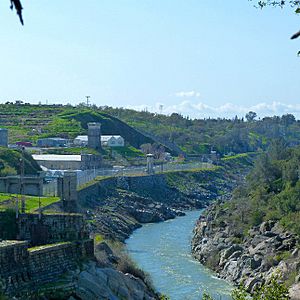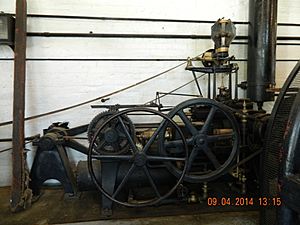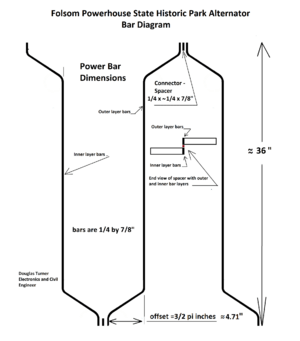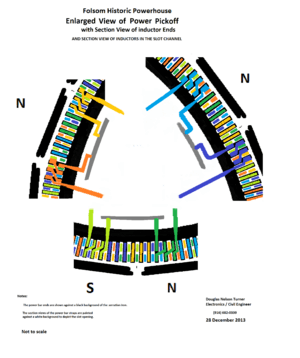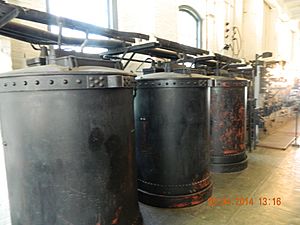Folsom Powerhouse State Historic Park facts for kids
|
Folsom Powerhouse
|
|
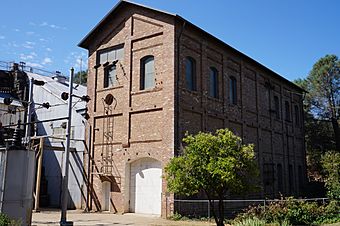
Folsom Powerhouse on the American River in July 2015
|
|
| Location | Folsom, California |
|---|---|
| Built | 1895 |
| Architect | H.T. Knight; Sacramento Electric Power & Light Co |
| NRHP reference No. | 73000426 |
Quick facts for kids Significant dates |
|
| Added to NRHP | October 2, 1973 |
| Designated NHL | May 29, 1981 |
The Folsom Powerhouse State Historic Park is a special place that keeps alive an amazing piece of history. It protects an old power station built in 1895. This station was one of the very first in the United States to use alternating current (AC) to make electricity from rushing water.
Before this powerhouse, most electric stations used direct current (DC) generators. These were often powered by steam engines and could only send electricity a short distance. It wasn't easy or cheap to send power from rushing water (hydroelectric power) over long distances if it was low-voltage DC.
But then, AC power changed everything! With AC, engineers could use new devices called transformers. These transformers could change low-voltage electricity into high-voltage electricity. High-voltage power could travel much farther without losing too much energy. Then, near where people needed the power, other transformers would change it back to a safer, lower voltage. DC power cannot use transformers to change its voltage.
The Folsom Powerhouse used the American River's strong current to spin its turbines. These turbines were connected to new AC generators. It made three-phase, 60-cycle AC electricity, which is the same kind we use in the United States today! Transformers then boosted this power from 800 volts to 11,000 volts. This high-voltage power traveled 22 miles (35 km) to Sacramento. This was one of the longest electricity lines in the country at that time.
Contents
A Big Step for Electricity
In Sacramento, the 11,000-volt AC power was changed back to a lower, usable voltage. The Folsom Powerhouse showed that you could make a lot of electricity far away from where people used it. It proved that hydroelectric power was a great and affordable way to get energy, even if the power plant was far from cities. The Folsom Powerhouse is located about 23 miles (37 km) from Sacramento, in the city of Folsom.
Powerhouse History
The Folsom Powerhouse worked for 57 years! It finally closed in 1952. This happened when the original dam on the American River was taken down to build the much bigger Folsom Dam.
Pacific Gas and Electric, the company that owned the plant since 1902, gave the powerhouse and most of its equipment to the State of California. This happened when the new Folsom Dam and its own power plant were built. California then made the site a California Historical Landmark in 1956. The powerhouse became a U.S. National Historic Landmark in 1981.
Today, the two-story brick and granite powerhouse looks almost exactly as it did in 1895. You can still see its huge generators and the fancy control switchboard. These impressive machines stand just as they did over a hundred years ago. You can learn how the powerhouse worked through old photos, displays, and tours. Some of the original water turbines and generators are still there!
How AC Power Changed Everything
Before AC generators and transformers were invented, only DC generators existed. They could only send power a few miles because too much energy was lost over long distances. This meant early power stations had to be built right in neighborhoods. For example, the Pearl Street Station in New York City, built in 1882, served customers only within about 2 miles (3 km).
But AC power changed this! Transformers allowed power to be sent at very high voltages over hundreds of miles. Then, it could be changed back to lower voltages for use. The AC generators and water turbines at Folsom were so big they couldn't travel by train. They had to be shipped 19,000 miles (30,578 km) around Cape Horn by boat!
On July 13, 1895, the Folsom Powerhouse sent its first electricity to Sacramento. This made it one of the first places in the United States to send hydroelectric power over a long distance. It even started working before the famous Niagara Falls Adams Power House began sending AC power to Buffalo, New York in 1897.
Water Supply for Power
The Folsom hydroelectric plant got its water from a special dam built in the 1890s. This dam was 650 feet (198 m) long and 89 feet (27 m) tall. It sent a huge stream of water into a 2.5-mile (4 km) long canal called the East Canal.
This canal was 50 feet (15 m) wide and 8 feet (2 m) deep. It carried about 85,000 cubic feet (2,407 cubic meters) of water every minute! The canal ran next to the river but sloped less steeply. This made the water gradually rise about 85 feet (26 m) above the river.
The dam and canal were finished in 1893. They were partly built using prison labor from the nearby Folsom State Prison. The way the canal was designed gave the power plant a "water head" of about 85 feet (26 m). This means the water fell from a height of 85 feet before going back into the American River.
The water from the canal flowed into a "forebay," which is like a holding pond. Here, any trash or debris was removed from the water. Then, the clean water went into four large pipes called penstocks, each 8 feet (2.4 m) wide. There were also two smaller penstocks. Each penstock had gates that could be closed to stop the water flow for maintenance. The rushing water in these penstocks powered the large AC generators.
Powerful Turbines
The Folsom Powerhouse used four huge water turbines. These were some of the biggest ever built at the time! They were made by S. Morgan Smith Works in York, Pennsylvania. There were also two smaller turbines for the DC generators.
The powerful water from the American River rushed through these four large turbines. This spinning motion then powered the four AC generators. Two more turbines powered the smaller DC generators.
Governors for Steady Power
The four large turbines were directly connected to the AC generators. To make sure the electricity was always a steady 60 cycles per second (like today), the turbines needed to spin at a constant speed of 300 rotations per minute.
Special devices called centrifugal governors controlled the speed. They did this by adjusting how much water flowed into the turbines. This kept the power steady and reliable.
Amazing Alternators
The four AC generators, also called alternators, were incredibly powerful. They were some of the strongest "rotating armature" machines ever built for three-phase power.
These alternators were invented by Elihu Thomson. Each one weighed almost 30 tons (about 27,215 kg) and stood 8.5 feet (2.6 m) tall! They were made by the newly formed General Electric company in Schenectady, New York. Each generator could produce 750 kilowatts (1,005 horsepower) of electricity.
To power the 24 magnets inside the AC generators, a smaller DC generator was used. There was also a backup DC generator ready to take over if needed. All four AC generators could be connected together. This helped keep the electricity frequency stable when more power was needed.
Control Panel
The powerhouse had a special control panel, or switchboard. To help customers use electric clocks that needed a steady frequency, a "Frequency Indicator" was added.
Another tool, a "Synchroscope," was added to help connect multiple alternators and the power grid together smoothly.
Long Transmission Lines
The AC power made at Folsom (about 4,020 horse power or 3 MW) was changed to 11,000 volts. This happened at the power plant using twelve new air-cooled transformers. These transformers were invented by William Stanley, Jr..
The power then traveled to Sacramento on twelve bare copper wires. These wires were held up by ceramic insulators on tall cedar poles, about 40 feet (12 m) high. Having multiple wires meant there were four separate three-phase lines. This allowed for repairs or maintenance without shutting down the whole system. Telephone lines were also run beneath the power lines.
Once in Sacramento, the high-voltage power was sent close to where it was needed. Then, transformers changed it down to a lower, safer voltage for use. This is very similar to how electricity is delivered today! In 1895, electric streetcars were big users of electricity. They used DC electric motors, but these motors could only work a few miles from DC generators.
A special machine called a rotary converter was used to change AC power into DC power for these streetcars. Factories also used a lot of power.
The ability to change AC voltages up for long-distance travel and then down for local use was a huge advantage. It opened up new ways to get power to people. By 1900, the original air-cooled transformers at Folsom were replaced with more efficient oil-cooled ones.
The AC induction motor, invented in 1888, also helped AC power become popular. It allowed factories to use AC power directly, replacing their old steam engines. AC electricity, with its easy voltage changes using transformers, made possible the huge electrical grids we rely on every day.
On September 9, 1895, Sacramento celebrated the new power with a "Grand Electric Carnival." Thousands of light bulbs decorated the state capital to mark California's 45th birthday!
More Power Needed
As more people used electricity, a second powerhouse was built in 1897. It was located below the original one. This new building held another 750-kilowatt AC generator. It helped meet the growing demand for electricity in Sacramento for homes and public transportation.
By the early 1900s, even with the expanded Folsom Powerhouse, Sacramento needed even more electricity. So, bigger hydroelectric plants and dams were built on other rivers like the Yuba, Feather, and Tuolumne River. These new plants provided power for all of Northern California.
The California Gas and Electric Company bought the Folsom Powerhouse by 1902. When this company became the Pacific Gas and Electric Company in 1906, they updated the powerhouse and its water system.
See also




